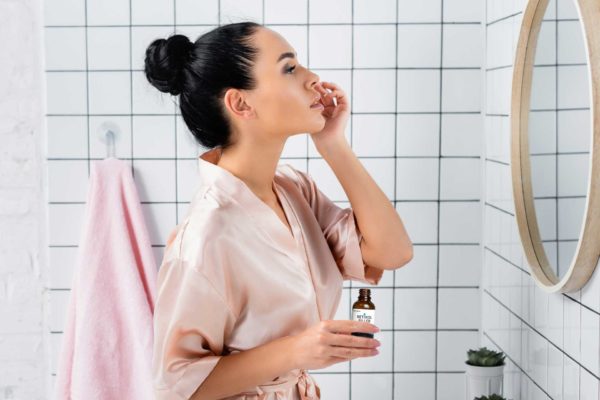
Inside The Rise Of The Midlife Facelift
By
1 year ago
We delve into the new world of facelifts
Annabel Jones reports on the rise in midlife facelifts and asks whether going under the knife is a smarter way to rejuvenate facial ageing after all
Are Facelifts The Answer To Ageing Well?
‘I honestly think I missed out on the facelift. Like an old-fashioned good one that you have when you’re like 44,’ actress Sarah Jessica Parker told radio host Howard Stern, joking ‘I’ve heard stories…’
The secrecy shrouding facelifts is something Kshem Yapa, a GMC-certified plastic surgeon specialising in facelifts and rhinoplasty, wants to change. ‘As life expectancy is rising, cosmetic surgery should ideally be one part of a wellness program – rather than this taboo thing that celebrities do under a cloak of secrecy,’ he says.
A point of frustration for surgeons such as Yapa is the unrealistic expectations that come with non-surgical treatments such as dermal filler. ‘You can’t camouflage facial laxity by adding more and more filler. It will start to look artificial,’ he explains. In some circles, artificial is the end goal but the over-stuffing now frighteningly common in tribes of young women and men is bringing facial surgery back to the fore for midlifers in search of a more authentic outcome. Even if it means going under the knife.

The Deep Plane Facelift
But then there are facelifts and then there are deep plane facelifts. In 2021, surgeon Anthony Jacono gave Marc Jacobs one which the fashion designer shared openly on social media. Before Jacobs and Jacono popularised it, the deep plane wasn’t common knowledge. Now it’s all anyone can talk about. Jacobs was 58 at the time of his facial surgery, though scroll Jacono’s Instagram page and a good swathe of his patients are in their 40s. This begs the question: is it better to lift earlier rather than later?
Yapa says you can’t put a number on the appropriate time to get a facelift, pointing out the obvious: ‘Everyone ages differently depending on their lifestyle and genetics.’ What is clear, says Yapa, is that the deep plane is usually more appropriate for those in midlife compared to the SMAS (superficial musculoaponeurotic system) facelift, which one could argue is the reason why we turned against facial surgery to begin with.
‘In a SMAS facelift, the surgeon dissects under the skin and fat which sits on top of the SMAS layer and then works on the SMAS from above using sutures to pick it up and lift it into a more youthful position. The skin is then redraped without any tension,’ says Yapa. This requires a level of artistry and taste alongside an understanding of what works on that patient’s anatomy for it to look good. A crude attempt at tightening the SMAS can result in an old-fashioned wind-tunnel look, a tell-tale sign you’ve had a facelift. A bad one at that.
The deep plane lift is more complicated. It entails dissecting the tissue deeper down, where the nerves and muscles lie, releasing the ligaments, then pulling the skin and SMAS in one composite movement. This, explains Yapa, de-tensions the facelift avoiding the telltale tightly pulled look.
How Much Do Facelifts Cost?
Let’s not be naive; such detailed intervention doesn’t come cheap (the New York Times reported in 2022 that a Jacono facelift costs $230,000, a figure that’s rumoured to have doubled since). And that’s not accounting for the maintenance – a facelift can need redoing every decade to maintain the uplift.
Although Yapa is more realistic: ‘Let’s be clear, nobody needs a facelift and patients are certainly not obligated to have it redone in ten years – many clients choose to invest in surgery once and accept the ageing process thereafter,’ he insists. Just as well if yours is costing anything close to Jacono’s.
Consultant plastic surgeon Georgios Orfaniotis, who operates out of the Montrose Clinic in Belgravia, has honed the art of the deep plane and charges a more reasonable fee: ‘I was probably one of the first to do deep planes in London. When I first started doing them, everybody was saying: ‘What is this guy doing, this is taking so long.’ Nobody could understand why I was doing this technique at the beginning.’ Then, he adds, ‘the Americans started promoting it and took it to the next level to where it now costs these crazy prices.
‘It’s not ethical. To be honest, no plastic surgery should cost that amount,’ says Orfaniotis who charges £29,000 for face and neck, a humble fee in comparison to the hundreds (of thousands) charged in New York and LA. Still, not bad for four hours work (the average time it takes to perform a deep plane facelift).
Orfaniotis isn’t shy to admit he likes to operate on younger people. ‘It can be a challenge, because sometimes the gains are marginal and you have to manage expectations, but in the right case a good, deep plane facelift can slow down the ageing process and create a nice foundation to age well further down the line.’
There are, of course, surgeons who believe a facelift should wait until a patient is at least 50, to which Orfaniotis argues: ‘I think a lot of it is the quality of the surgery. If it’s done well, it improves everything: skin quality, collagen, how the face moves, your facial expressions.’ And the subsequent lifts? ‘The first facelift is so important to get right. Then you can correct a little thing here and there in future without having to redo the whole thing,’ says Orfaniotis.
The investment pays dividends if you have your face tightened at 40, but what if you’re past the age when a deep plane makes sense? ‘A traditional SMAS lift is quicker to perform and is cheaper for the patient – and it’s easier to recover from – for this reason it can be a smarter option for older patients in their 70s and 80s,’ says Yapa, who stresses: ‘you can get good results from a SMAS too.’

Alternatives To Facelifts
Back to fillers: the rumour is they are the enemy for plastic surgeons. Not necessarily, Yapa says, but they can be problematic during surgery. ‘When dermal filler is overdone, it tends to sit around the dissection of tissue planes and when it’s injected in the wrong place – close to the nerves where you don’t want it – it takes time to remove, making facelift surgery more difficult.’
Scar tissue, says Yapa, can also be induced by energy treatments such as ultrasound. ‘Everyone wants to avoid general anaesthetic and so they’re looking for alternatives to a surgical facelift but energy treatments can cause fat necrosis leading to scarring.’ He adds: ‘When you dissolve fat with energy the deeper tissues can get lax, which changes the shape of the face.’
Dissolving pockets of fat around the jowls, for instance, may provide some instant gratification, but it doesn’t fix the underlying problem of tissue laxity, which can only be properly addressed with surgery, says Yapa, who prefers superficial treatments such as microneedling and radiofrequency, which rejuvenates the quality and texture of the skin rather than disturbing the structure beneath. ‘Hydrating injectables like Profhilo or precisely controlled lasers are a nice compliment to surgery,’ he suggests.
Orfaniotis is less keen on certain skin-boosting injectables. ‘I think it’s wise to avoid biostimulators. They create collagen but not the soft collagen that we want – some collagen creates fibrosis (scar tissue) that makes more work for us.’
Was filler and its co-stars just a momentary obsession we’ve overdosed on, one that’s ultimately led us back to basics – or can the two camps coexist in harmony? ‘In the future, I hope to see specialist injectors and surgeons working on a patient’s longevity plan together – a more holistic approach is definitely needed,’ says Yapa. Knife or needle, what remains true is ageing well is never just about one thing.









